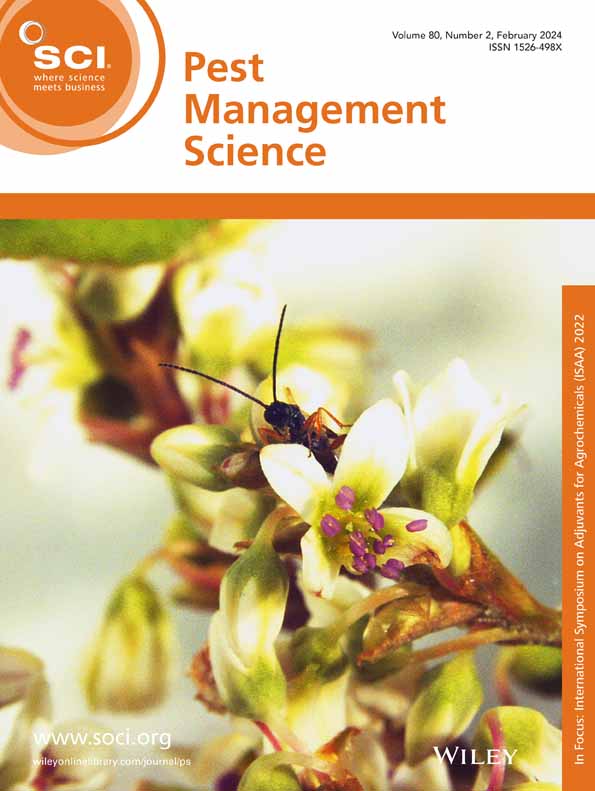含有t‐SNARE结构域的大豆囊线虫HgSNARE1是一种与GmSNAP18-GmSHMT08-GmPR1‐15模块相互作用的效应物,并显示出对大豆的毒性
IF 3.8
1区 农林科学
Q1 AGRONOMY
引用次数: 0
摘要
背景大豆囊线虫(Heterodera glycines, SCN)对大豆(Glycine max (L.))构成严重威胁,每年给全球大豆生产造成巨大的产量损失。虽然两个主要的大豆抗SCN基因rhg1 GmSNAP18和Rhg4 GmSHMT08已经被克隆出来,但SCN效应物很少被鉴定和发挥作用,效应物与大豆相互作用的分子机制仍然很大程度上未知。在此,我们鉴定了SCN效应因子HgSNARE1,并研究了它如何靶向大豆GmSNAP18-GmSHMT08-GmPR1‐15模块,旨在揭示SCN控制的新分子机制。结果在本研究中,含有t - SNARE结构域的蛋白HgSNARE1被鉴定为SCN的效应蛋白,在第三幼鱼期(J3)表达最高。HgSNARE1在大豆毛状根中的表达促进了大豆对SCN的抗性,说明HgSNARE1对大豆具有无毒作用。HgSNARE1通过t‐SNARE结构域与GmSNAP18相互作用,C末端的最后5个氨基酸残基(S308V309H310K311A312)在相互作用中起重要作用。GmSNAP18与GmSHMT08和发病机制相关(PR) 1蛋白GmPR1‐15 (Glyma.15 g062400)相互作用,GmSHMT08与GmPR1‐15相互作用。因此,GmSNAP18、GmSHMT08和GmPR1‐15通过两两相互作用形成一个模块。然而,GmSHMT08和GmPR1‐15都没有与HgSNARE1相互作用。此外,HgSNARE1在大豆毛状根中的表达刺激了GmPR1‐15的表达。结论这些发现揭示了SCN效应物HgSNARE1与GmSNAP18 - gmshmt08 - GmPR1 - 15模块中抗SCN的GmSNAP18相互作用并促进GmPR1 - 15表达从而赋予毒性的新分子机制,为开发新的抗SCN种质资源和创新的线虫管理策略提供了潜在的靶点。©2025化学工业协会。本文章由计算机程序翻译,如有差异,请以英文原文为准。
The t‐SNARE domain‐containing soybean cyst nematode HgSNARE1 is an effector that interacts with the GmSNAP18–GmSHMT08–GmPR1‐15 module and shows avirulence to soybean
BACKGROUNDSoybean cyst nematode (SCN, Heterodera glycines ) poses a significant threat to soybean (Glycine max (L.)), causing huge yield losses annually in global soybean production. Although the two main soybean SCN‐resistant genes, rhg1 GmSNAP18 and Rhg4 GmSHMT08 , have been cloned, the SCN effectors have been identified and functioned rarely, and the molecular mechanisms of effectors interacting with soybean remain largely unknown. Here, we identified the SCN effector HgSNARE1 and investigated how it targeted the soybean GmSNAP18–GmSHMT08–GmPR1‐15 module, aiming to reveal a new molecular mechanism for SCN control.RESULTSIn this study, the t‐SNARE domain‐containing protein HgSNARE1 was identified as an effector from SCN that was expressed the highest at the third juvenile (J3) stage. Expression of HgSNARE1 in soybean hairy roots promoted SCN resistance, indicating the avirulence function of HgSNARE1 to soybean. HgSNARE1 interacted with GmSNAP18 via the t‐SNARE domain, with the last five amino acid residues (S308 V309 H310 K311 A312 ) in the C terminus playing an essential role in the interaction. GmSNAP18 interacted with both GmSHMT08 and a pathogenesis‐related (PR) 1 protein GmPR1‐15 (Glyma.15 g062400), and GmSHMT08 interacted with GmPR1‐15. Therefore, GmSNAP18, GmSHMT08 and GmPR1‐15 formed a module by pairwise interactions. However, neither GmSHMT08 nor GmPR1‐15 interacted with HgSNARE1. Furthermore, expression of HgSNARE1 in soybean hairy roots stimulated expression of GmPR1‐15 .CONCLUSIONThese findings reveal a novel molecular mechanism by which the SCN effector HgSNARE1 interacts with SCN‐resistant GmSNAP18 of the GmSNAP18–GmSHMT08–GmPR1‐15 module and promotes GmPR1‐15 expression to confer avirulence, providing a potential target for the development of new SCN‐resistant germplasms, and innovative nematode management strategies. © 2025 Society of Chemical Industry.
求助全文
通过发布文献求助,成功后即可免费获取论文全文。
去求助
来源期刊

Pest Management Science
农林科学-昆虫学
CiteScore
7.90
自引率
9.80%
发文量
553
审稿时长
4.8 months
期刊介绍:
Pest Management Science is the international journal of research and development in crop protection and pest control. Since its launch in 1970, the journal has become the premier forum for papers on the discovery, application, and impact on the environment of products and strategies designed for pest management.
Published for SCI by John Wiley & Sons Ltd.
 求助内容:
求助内容: 应助结果提醒方式:
应助结果提醒方式:


